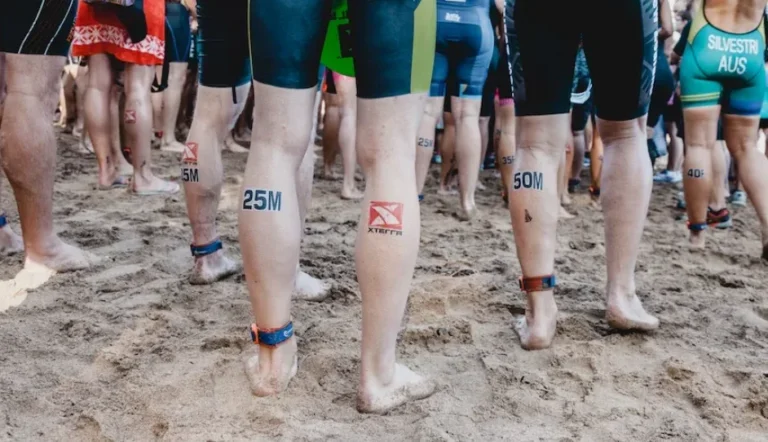In the context of triathlon training, a “brick” refers to a workout that combines two disciplines back-to-back, most commonly cycling followed immediately by running.
The primary objective of a brick workout is to simulate the transition between the bike and run segments of a triathlon, helping athletes acclimate to the unique sensation of switching disciplines without a break.
The Origin of the Term “Brick”
The term “brick” has an interesting origin. While there are various theories, one popular belief is that the name stems from the heavy, leg-numbing sensation athletes experience when transitioning from cycling to running, as if their legs feel like “bricks.” This sensation is a result of different muscle groups being activated in quick succession, and brick workouts aim to make this transition smoother.
Frequency of Brick Sessions
The frequency of brick sessions largely depends on the athlete’s experience, the race they’re training for, and where they are in their training cycle.
- Beginners: Those new to triathlon might start with one brick session every 7-10 days, allowing ample recovery.
- Intermediate Athletes: As proficiency grows, athletes can incorporate a brick workout once a week, especially during peak training phases.
- Advanced Triathletes: Experienced athletes, especially those training for longer distances like Ironman events, might include multiple brick sessions in a week, varying in intensity and duration.
Brick workouts for triathletes
1. Starting Simple: The Foundations of Brick Workouts
For novices, the world of brick workouts can seem daunting. The key is to begin with manageable sessions that mirror your current fitness level.
Example: A beginner might start with a relaxed 30-minute bike ride on a flat route. Following this, without any prolonged break, they would transition into a 10-minute jog. This initial foray into brick workouts allows the athlete to experience the unique sensation of switching disciplines, preparing their body and mind for more intensive sessions in the future.
2. Gradual Progression: Building Stamina and Strength
Just as a building is constructed brick by brick, your proficiency with brick workouts will grow with consistent and gradual progression.
Example: After several weeks of consistent training and as endurance improves, the same athlete could challenge themselves with a 45-minute bike ride involving some hill work. This could be immediately followed by a 20-minute run, incorporating short bursts of increased pace to simulate race conditions.
3. Simulating Race Conditions: Preparing for the D-Day
One of the primary objectives of brick workouts is to prepare athletes for the unique demands of race day. This involves not just physical preparation but also mental conditioning.
Example: If an athlete is training for a sprint triathlon, they might attempt a brick workout that covers the actual race distances but at a slightly reduced pace. This not only familiarizes them with the endurance required but also boosts confidence.
4. Focusing on Transitions: The Fourth Discipline
Transitions in a triathlon are often termed the “fourth discipline.” They can make or break an athlete’s race, and hence, practicing them is crucial.
Example: After a cycling session, an athlete might set up a mini transition zone in their training area. Here, they would practice the swift change from cycling shoes to running shoes, ensuring they can do this efficiently even under fatigue.
5. Incorporating Variety: Keeping Training Dynamic
While the bike-to-run session is the quintessential brick workout, there’s value in diversifying training to keep it engaging and holistic.
Example: An athlete might incorporate a swim-to-bike brick. After a pool session, they can quickly transition to a stationary bike or head out for a road cycle. This not only simulates the first transition of a triathlon but also challenges the body in new ways.
6. Recovery: The Unsung Hero of Training
Brick workouts, given their demanding nature, place significant stress on the body. Recognizing the importance of recovery is paramount.
Post-Workout Recovery Tips:
- Stretching: Engage in a 10-15 minute cool-down stretching routine, focusing on the major muscle groups activated during the workout.
- Hydration: Replenish lost fluids by drinking water or electrolyte solutions to aid in muscle recovery and prevent cramps.
- Nutrition: Consume a balanced post-workout meal or shake, rich in proteins and carbohydrates, to kickstart the muscle repair process.
In Conclusion
The brick workout is a cornerstone of triathlon training, designed to bridge the gap between individual disciplines and create a cohesive race-day experience. By regularly incorporating and mastering brick sessions, triathletes can significantly enhance their transition efficiency, conserve energy, and improve overall race performance. As with all training endeavors, the key is consistency, progression, and listening to one’s body. Whether you’re a novice or a seasoned triathlete, may your brick workouts lay a solid foundation for your triathlon success!
